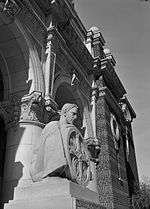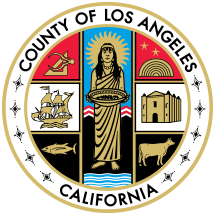Natural History Museum of Los Angeles County
 | |
| Established | 1913 |
|---|---|
| Location | Exposition Park, Los Angeles, California |
| Type | Natural history museum |
| Visitors | About 1,000,000 Annually |
| Director | Dr. Lori Bettison-Varga[1] |
| Public transit access |
Expo/Vermont (Expo Line) |
| Website | |
|
Natural History Museum | |
   | |
| Location | 900 Exposition Blvd., Los Angeles, California |
| Coordinates | 34°1′1″N 118°17′16″W / 34.01694°N 118.28778°W |
| Area | 6 acres (2.4 ha) |
| Built | 1913 |
| Architect | Hudson & Munsell |
| Architectural style | Beaux Arts, Neoclassical, Romanesque, Spanish Plateresque |
| NRHP Reference # | 75000434[2] |
| Added to NRHP | March 4, 1975 |
The Natural History Museum of Los Angeles County (abbreviated NHM) is the largest natural and historical museum in the western United States,[3] Its collections include nearly 35 million specimens and artifacts and cover 4.5 billion years of history. This large collection is comprised not only of specimens for exhibition, but also of vast research collections housed on and offsite.
The Museum is actually an association of three Los Angeles area museums; The Natural History Museum of Los Angeles County, the Page Museum at the La Brea Tar Pits in Hancock Park and the William S. Hart Ranch and Museum in Newhall, Santa Clarita, California. The three museums work together to achieve their common mission: "to inspire wonder, discovery, and responsibility for our natural and cultural worlds."[4]
History

NHM opened in Exposition Park, Los Angeles, California, United States in 1913 as the Museum of History, Science, and Art. The moving force behind it was a museum association founded in 1910. Its distinctive main building, with fitted marble walls and domed and colonnaded rotunda, is on the National Register of Historic Places. Additional wings opened in 1925, 1930, 1960, and 1976.
The museum was divided in 1961 into the Los Angeles County Museum of History and Science and the Los Angeles County Museum of Art (LACMA). LACMA moved to new quarters on Wilshire Boulevard in 1965, and the Museum of History and Science was renamed the Los Angeles County Museum of Natural History. Eventually, the museum renamed itself again, becoming the Natural History Museum of Los Angeles County.
In 2003, the museum began a campaign to transform its exhibits and visitor experience. The museum reopened its seismically retrofitted renovated 1913 rotunda, along with the new Age of Mammals exhibition.[5] in 2010. Its Dinosaur Hall opened in July 2011. A new Los Angeles history exhibition, Becoming Los Angeles, opened in 2013. The outdoor Nature Gardens and Nature Lab, which explore L.A. wildlife, also opened in 2013.
Research and Collections

The museum maintains research and collections in the following fields:
- Annelida
- Anthropology and Archaeology
- Ethnology
- Crustacea
- Echinoderms
- Entomology
- Herpetology
- History
- Ichthyology
- Invertebrate paleontology
- Malacology
- Mammalogy
- Mineralogy
- Ornithology
- Vertebrate paleontology
The museum has three floors of permanent exhibits. Among the most popular museum displays are those devoted to animal habitats, dinosaurs, pre-Columbian cultures, the Ralph M. Parsons Discovery Center and Insect Zoo, and the new Nature Lab, which explores urban wildlife in Southern California.
The museum's collections are strong in many fields, but the mineralogy and Pleistocene paleontology are the most esteemed, the latter thanks to the wealth of specimens collected from the famed La Brea Tar Pits. The museum has almost 30 million specimens representing marine zoology.
The museum's collection of historical documents is held in the Seaver Center for Western History Research.[6]
Special Exhibits
The Museum hosts regular special exhibitions which augment its collections and advance its mission. Recent special exhibits have included Mummies and Pterosaurs.
The museum also hosts a butterfly pavilion outside every spring and summer and a spider pavilion on the same site in the fall.
Architecture
Over the years, the museum has built additions onto its original building. Originally dedicated when the Natural History Museum opened its doors in 1913, the Rotunda is one of the Museum's most elegant and popular spaces. Lined with marble columns and crowned by a stained glass dome, the room is also the home of the very first piece of public art funded by Los Angeles County, a Beaux Arts statue by Julia Bracken Wendt entitled "Three Muses," or History, Science and Art. [7] This hall is among the most distinctive locales in Los Angeles and has often been used as a filming location.
References
- ↑ Mike Boehm (July 8, 2015). "Lori Bettison-Varga named new president of L.A. County's Natural History Museum". Latimes.com. Retrieved July 15, 2016.
- ↑ National Park Service (2010-07-09). "National Register Information System". National Register of Historic Places. National Park Service.
- ↑ "Los Angeles County.". Lacounty.gov. Retrieved July 15, 2016.
- ↑ http://www.nhm.org/site/about-our-museums/mission
- ↑ Suzanne Muchnic (July 4, 2010). "'Age of Mammals' at the Natural History Museum". Los Angeles Times.
- ↑ "About the Seaver Center". Natural History Museum Los Angeles County. Retrieved 31 December 2016.
- ↑ Rubenstein, Charlotte Streifer, ‘’American Women Sculptors: A History of Women Working in Three Dimensions’’, G. K. Hall and Co. Boston, 1990 p. 108
External links
| Wikimedia Commons has media related to Natural History Museum of Los Angeles County. |
- Natural History Museum of Los Angeles County official website
- William S. Hart Ranch and Museum
- George C. Page Museum at the La Brea Tar Pits
- Review of the Museum's new Dinosaur Hall at the New York Times, July 19, 2011
Coordinates: 34°01′01″N 118°17′20″W / 34.016989°N 118.288781°W
